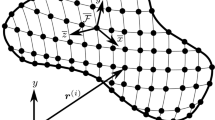Abstract
A general multi-body formulation to analyze the tolerance effects on the statistical property variations of natural frequencies of multi-body systems undergoing constant rotational motion is proposed in this paper. To obtain the tolerance effects, Monte-Carlo simulation method is conventionally employed. However, the Monte-Carlo simulation has serious drawbacks; spending too much computation time for the simulation and achieving very slow convergence around some dynamically unstable regions. To resolve such problems, a method employing analytical sensitivity information is suggested in this paper. To obtain the sensitivities of natural frequencies the eigenvalue problem should be differentiated with respect to a design variable. The sensitivities of mass and stiffness matrices should be calculated at the dynamic equilibrium. By employing the sensitivities of natural frequencies along with the tolerance of the design variable, the statistical property variations of the natural frequencies can be calculated.
Similar content being viewed by others
References
D. H. Choi, J. H. Choi, J. H. Park and H. H. Yoo, “Steady-State equilibrium analysis of a multibody system driven by constant generalized speeds,” KSME International Journal, 16(10) (2002) 1239–1245.
V. N. Sohoni and J. Whitesell, Automatic linearization of constrained dynamical models, ASME Journal of Mechanisms, Transmissions, and Automation in Design, 108 (1986), 300–304.
D. H. Choi, J. H. Park and H. H. Yoo, Modal analysis of constrained multibody systems undergoing rotational motion, Journal of Sound and Vibration, 208(1) (2005), 63–76.
R. S. Hartenberg and J. Denavit, Kinematic synthesis of linkages, McGraw-Hill, New York, USA, (1964).
R. E. Garret and A. S. Hall, Effects of tolerance and clearance in linkage design, ASME Journal of Engineering for Industry, 91 (1969) 198–202.
S. Dobowsky and F. Freudenstein, Dynamic analysis of mechanical systems with clearances, Part 1: Formulation of dynamic model, ASME Journal of Engineering for Industry, 90 (1971) 305–316.
S. Dobowsky, On predicting the dynamic effects of clearances in planar mechanisms, ASME Journal of Engineering for Industry, 96 (1974) 317–323.
S. J. Lee, Performance reliability and tolerance allocation of stochastically defined mechanical systems, The Pennsylvania State University, Ph.D. Dissertation, (1989).
S. J. Lee and B. J. Gilmore, The determination of the probabilistic properties of velocities and accelerations in kinematic chains with uncertainty, ASME Journal of Mechanical Design, 113 (1991), 84–90.
E. J. Haug, Computer-aided kinematics and dynamics of mechanical systems, VolumnVolume I: Basic Method, ALLYN AND BACON (1989).
S. S. Kim and M. J. Vanderploeg, A general and efficient method for dynamic analysis of mechanical systems using velocity transformations, ASME Journal of Mechanisms, Transmissions and Automation in Design, 108 (1986) 176–182.
D. S. Bae and E. J. Haug, A recursive formulation for constrained mechanical system dnamics: Part I. open loop systems, Mech. Struct. & Mach., 15(3) (1987) 359–382.
C. S. Rudisill, 1974, Derivatives of eigenvalues and eigenvectors of a general matrix, AIAA Journal, 12 (1974) 721.
Author information
Authors and Affiliations
Corresponding author
Additional information
This paper was recommended for publication in revised form by Associate Editor Seockhyun Kim
Seung Man Eom graduated from the Department of Mechanical Engineering at Incheon University in 2005 and received his master degree from the Department of Mechanical Engineering at Hanyang University in 2007. He is currently working as a Researcher of Aircraft Development Team in KIAT(Korea Institute of Aerospace Technology, Koreanair), DaejeonDeajeon, Korea.
Bum Suk Kim graduated from the School of Mechanical Engineering at Hanyang University in 2006 and received his master degree from the same department in 2008. He is currently working as a Ph.D. student in the School of Mechanical Engineering in Hanyang University, Seoul, Korea.
Hong Hee Yoo graduated from the Department of Mechanical Design and Production Engineering at Seoul National University in 1980 and received his master degree from the same department in 1982. He received his Ph.D. degree in 1989 from the Department of Mechanical Engineering and Applied Mechanics in the University of Michigan at Ann Arbor, U.S.A. He is currently working as a professor in the School of Mechanical Engineering in Hanyang University, Seoul, Korea.
Rights and permissions
About this article
Cite this article
Eom, S.M., Kim, B.S. & Yoo, H.H. Tolerance effects on natural frequencies of multibody systems undergoing constant rotational motion. J Mech Sci Technol 22, 2163–2170 (2008). https://doi.org/10.1007/s12206-008-0749-2
Received:
Revised:
Accepted:
Published:
Issue Date:
DOI: https://doi.org/10.1007/s12206-008-0749-2




